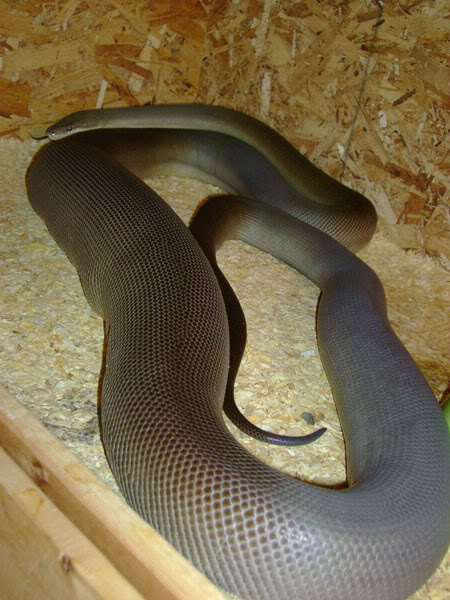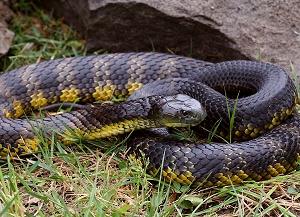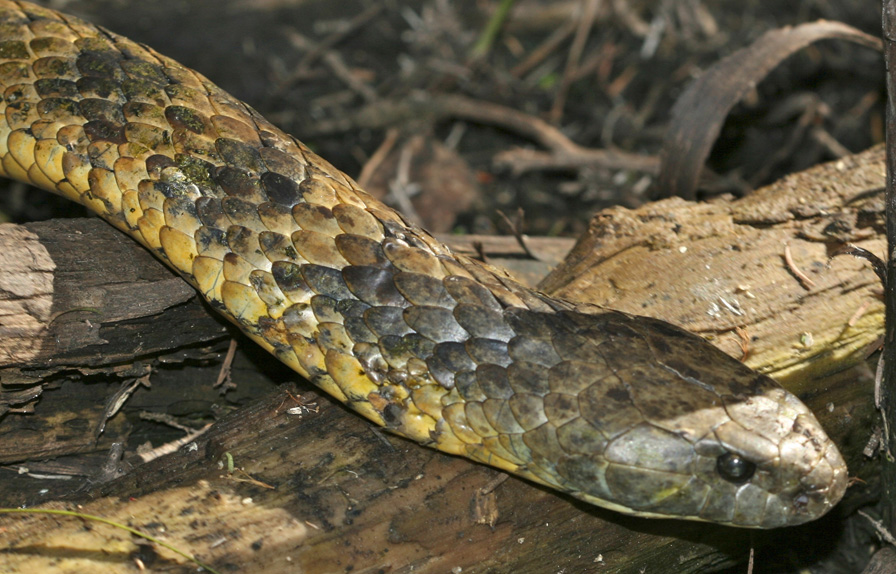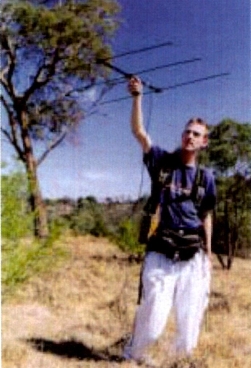A Crocodile Called Casey
/It was about two years ago when Steve - funny there is another bloke of that name who mucks around with crocodiless too - ran a fishing camp on an island in the Adelaide River, a known crocodile breeding ground. Steve Timmons was pretty new to the area, he knew there were plenty of crocodiles in the river and that they were dangerous, but he didn't know much about them. And he wasn't prepared for his first meeting with Casey.
We'll let Steve continue the crocodile story
The island itself is long and narrow, the living area is only 50 metres at best from the river and that's in the dry season. In the wet season the water floods the kitchen. There is a resident saltie on this island named Casey, a name given to her by the owners of the island. She, because she's a pretty crocodile. Anyway, Casey is used to being around humans in fact, I think she likes them.
One night, as I was cooking dinner by myself, I noticed this crocodile hanging around at the back of the kitchen. Hmm! Not a large crocodile, only about three metres, but definitely a saltie. I don't know whether this is the one I was told about or not, we were never introduced.
 I was inside, it was outside and we were both curious. I continued to cook dinner thinking I could take a photo later.
I was inside, it was outside and we were both curious. I continued to cook dinner thinking I could take a photo later.
Well, this crocodile wasn't having any of this. "If you ignore me, I'll just come in." As I turned away from the stove, I saw this bloody lizard, crawl into the kitchen. It just lay there looking at me like I was dinner. So here I was, caught between a croc and a hot place, with this walking handbag blocking the only exit. I must admit that the camp oven smelt good, but the ever-strengthening smell of methane was blowing my cool. We just stood there looking at each other waiting to see who would make the first move.
If I climbed onto the bench, I would have to turn my back on the croc and even if I made it onto the bench, a three metre croc could easily get me. I thought of grabbing a knife and doing a Crocodile Dundee turnout, you know, do a western roll, whipping out the bowie knife in mid-air and stabbing it in the brain. This, by the way is the only way to kill a croc outright, right between the eyes five centimetres back. But a croc's head is one-sixth of its total length and I was in no position to get past those jaws; and a butter knife does not instil confidence.
Where the hell is Steve Irwin when you need him. He could jump on its back and distract it. Did I think of that? No bloody way.
The croc just lay there, legs cocked ready to pounce, even if I could jump high enough to miss those massive jaws the ceiling fan would get me. I've got a gun, but it's on the table behind the croc. You idiot! We both just stood our ground waiting for the first move. Then for some reason the croc relaxed its haunches and lowered it's head to the floor, but stayed put.
Hmmm, it must be hungry. There's a barra carcass on the bench and the fillets are in the camp oven. It's bloody amazing what you think of when you are expecting pain. I grabbed the carcass and with an almighty heave, it was the worst throw of all time, the barra landed a metre away from me! The croc lunged forward at a such rate that I didn't have time to move, picked up the carcass, chomped it a couple of times, broke it in half, picked up the head, crushed it with those massive jaws, gave me a wink and then just turned away and left.
By this time I had lost my appetite.
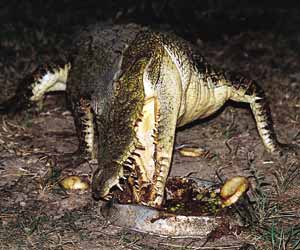 This, apparently, was Casey. I'm very glad it wasn't a mean one! Casey became a regular at my back door during meal times. I found a bowl and put food in it every night - yes she eats out of a bowl. Some say I should have shot her, some say that I'm crazy to feed her, but it did stop her from coming in. She became a sideshow for visitors. Do I trust a crocodile? Not a chance!
This, apparently, was Casey. I'm very glad it wasn't a mean one! Casey became a regular at my back door during meal times. I found a bowl and put food in it every night - yes she eats out of a bowl. Some say I should have shot her, some say that I'm crazy to feed her, but it did stop her from coming in. She became a sideshow for visitors. Do I trust a crocodile? Not a chance!
Then there was a caretaker named Paul. A large, strapping bloke with a voice that roared. He would thump around the place, cursing and yelling. I think the vibrations he gave off actually attracted Casey. She would follow him around the island.
Sometimes she would hide in the long grass near the generator, which needed to be refuelled regularly, and would bolt out and say "hi ya bloke!" She was always somewhere around the island.
One day Paul was working on the outboard, bent over, head near the water, she surfaced to say hello. This of course, gave him a big scare - as it would. Paul yelled and cursed like a bullock teamster, Casey just stayed there and smiled.
Paul and Casey spent a lot of time around each other, balmy nights sitting under a palm tree at the back of the kitchen with a bottle of rum to get the chitchat started. Paul discovered that Casey would chomp on anything that he threw at her, some things she liked, some things she didn't but she would always have a go. This was a great way to crush beer cans, but she worked out quickly that they were not food and became annoyed.
One night Casey came up to feed, the pantry was bare, except for some spuds. Not wanting a hungry croc on his hands, Paul sliced the spuds thickly and fried them in the camp oven. By the time the spuds were cool the lizard was getting toey, so he threw a couple at her - she loved them. From then on it was vegetarian crocodile, a little gravy, a few leftover peas in the bowl and everything was Humpty Doo. I was told that she liked TV snacks. Yeah? And I'm gunna believe that!
Anyway! We had a mob of local bird watchers out for the weekend, they called themselves the Scrub Fowls, which actually suits them. "G'day Denise." They brought everything that was nice to eat including chocolate mud cake. Casey had finished dinner, I thought we might like desert.
Now, a croc, usually, just chomps and swallows. Casey, picked up the mud cake and left her mouth open while the cake dissolved, then actually seemed to savour the taste and swallow it gently. If a croc's tongue wasn't welded to its lower jaw, I'm sure she would have licked her lips. TV snacks get the same reaction, plus they're easier to keep.
So, you're thinking "What a crocodile!"
I'm say'n, "well yeah. She is!" You don't believe me do you? Well I have photos. During his time on the island Steve became quite attached to Casey, and in true bushy-style he even wrote a poem about her.
Copyright by Club Marine Limited.
Crocodile - one fascinating find.







